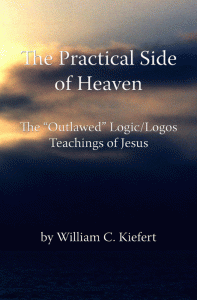
Copyright William C. Kiefert. All Rights Reserved.
Originally written on April 24, 2002.
It is as difficult to push square pegs into round holes as it is to stuff everything we know about Jesus into one box. To do “on earth as it is in heaven” and also the “greater things” Jesus promised we could, we must stop limiting him to the “historical method” of interpretation. This is an outdated product of the Roman Emperor Constantine’s demand at the Council of Nicaea (325AD) that the church be unified under “one” doctrine.
Jesus did more than die for us. He also taught us a godlike, non-judgmental process of reasoning, the logos or logic of God. Combining the non-judgmental logic with the present judgmental process (Aristotelian Logic) expands our consciousness of reality. In this renewed or enlightened consciousness, unused potentials of our mind are awakened, empowering us to do what Jesus promised we could.
In John 8: 31-32jvb, for example, Jesus said: “If you make my word your home, you will learn the truth and the truth will set you free.” The Word or Will of God is the English translation of the Greek term logos. To many early Christians (Gnostic Christians), the logos of God referred to the higher logic or reasoning of God (Paul Tillich, A History of Christian Thought pg. 31).
Letting Jesus out of the “historical” box frees us to understand his ministry in ways that the world can no longer afford to deny. For example, we would no longer be limited to interpreting the Greek phrase henos anthropos in Rom. 5:12 as “one man” who, according to St. Augustine (419 AD), was Adam. From a Gnostic Christian point of view, henos anthropos refers to the basic axiom upon which judgmental systems of logic rest. Namely, every class (meaning every object or idea, including mankind) has one nature. For example, when Paul said “sin came into the world through “henos anthropos,” he meant that sin came into the world because we limit ourselves to a judgmental system of logic, which is based on the assumption that all classes, including mankind, have one nature (henos anthropos). Plato’s theory of Forms is a written example of that axiom.
From outside the box, we can also understand that, even though both words later came to mean “cross,” the Greek term sklops refers to a pole on which criminals were crucified. The Greek term stauros, “used only by Jesus and Paul” (John L. McKenzie sj, Dictionary of the Bible, pg.162), refers to an equilateral cross (+). Jesus and Paul use word stauros (+) as a logo which represents four human natures or mankinds (anthropoi). Just as henos anthropos (one mankind) refers to the axiom justifying our judgmental system of logic, so does anthropoi (mankinds), symbolized by stauros (+), refer to an axiom that justifies creating a non-judgmental system of logic. In effect, judgmental systems of logic apply to single-nature classes like elements on the periodical chart. Non-judgmental logic applies to multiple-nature classes such as mankind, time, light and mass.
When Jesus said: “Bring the children unto me”, he intended to teach them non-judgmental/logos logic. He knew that just as hate is teachable, so is love. To learn how to reason non-judgmentally is to learn how to reason lovingly. Such reasoning is the missing fourth “R” in education. Isn’t learning to reason non-judgmentally or lovingly as important as learning reading, writing and arithmetic?
In conclusion: I believe that by freeing Jesus from the “box” Constantine forced him into, within a few generations, our children will be conscious of one another in more loving ways. Then, and only then, will “Thy will be done on earth as it is in heaven.” Your thoughts on this will be greatly appreciated.

LEARN MORE ABOUT PROPHET JESUS (A.S) AND HIS ARRIVAL TO EARTH IN THE NEAR FUTURE. http://islamicsocialsystems.blogspot.com/